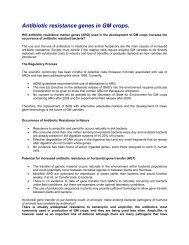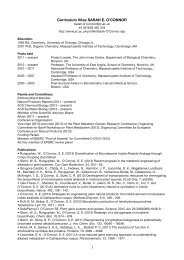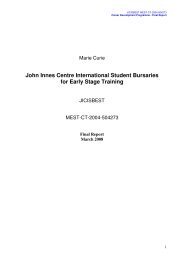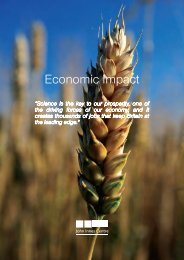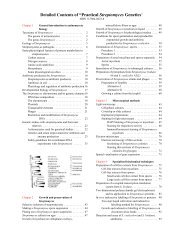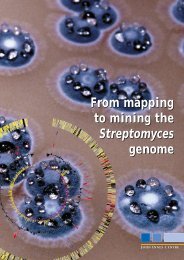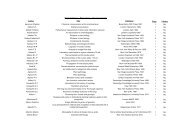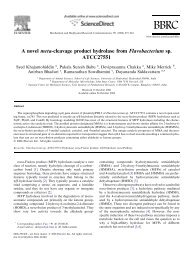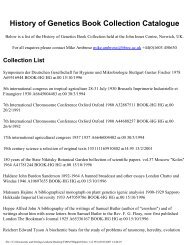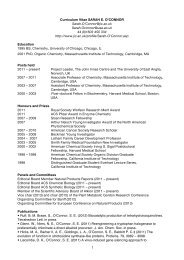1910s Timeline - John Innes Centre
1910s Timeline - John Innes Centre
1910s Timeline - John Innes Centre
You also want an ePaper? Increase the reach of your titles
YUMPU automatically turns print PDFs into web optimized ePapers that Google loves.
1930s Chemical nature of<br />
nucleic acid investigated<br />
Nucleic acid was thought to be a<br />
tetranucleotide composed of<br />
one unit each of adenylic,<br />
guanylic, thymidylic and<br />
cytidylic acids. The ubiquitous<br />
presence of nucleic acid in the<br />
chromosome was generally<br />
explained in purely physiological<br />
terms<br />
1930s-40s M B Crane, D Lewis<br />
and associates elucidate the<br />
genetically controlled<br />
incompatibility mechanism in<br />
plants and its practical<br />
application to economic crops<br />
During the 1930s the study of<br />
pollen incompatibility and<br />
sterility which has been going<br />
on for some years is extended<br />
from cherries, plums and apples<br />
to pears. Cytological<br />
examination of the varieties<br />
available begins. Morley<br />
Benjamin Crane’s pollination<br />
experiments (assisted by W J C<br />
Lawrence in the 1920s and A. G<br />
Brown from 1935) have allowed<br />
fruit trees to be grouped<br />
according to whether they are<br />
self-fertile (set fruit with their<br />
own pollen) or whether they<br />
require cross-pollination with<br />
another variety. By the end of<br />
the 1930s about a million<br />
pollinations have been made at<br />
JIHI to test the success of<br />
crosses that can happen in the<br />
orchard, and Crane is able to<br />
publish practical rules on which<br />
of the main varieties should be<br />
planted together to give good<br />
crops of fruit and which should<br />
not; his advice is regularly<br />
sought by fruit growers.<br />
Despite their practical value,<br />
these findings in themselves<br />
offer no real insight into the<br />
genetic mechanisms<br />
determining incompatibility<br />
relations. The hypothesis that<br />
incompatibility relations are<br />
determined by a series of allelic<br />
genes, denoted by S 1 , S 2 , S 3 …,<br />
was formulated by E. M. East<br />
and A. J. Mangelsdorf in 1925,<br />
but it had not been possible to<br />
apply this insight to explain the<br />
more complicated cases of<br />
incompatibility relations in fruit.<br />
The first clue came from the<br />
young C. D. Darlington’s<br />
chromosome counts in a<br />
number of Prunus species in the<br />
mid-1920s which established<br />
that sweet cherries were diploid,<br />
sour cherries tetraploid and the<br />
plums hexaploid. These findings<br />
helped to explain some of the<br />
complexity in the relationships<br />
between pollen and style.<br />
Further advances are made by<br />
Dan Lewis (Assistant<br />
Pomologist) from 1940 using<br />
the more amenable species<br />
Oenothera organensis as a<br />
model plant. By inducing<br />
tetraploidy in this plant Lewis is<br />
able to analyse the relations of<br />
pairs of S alleles in detail. Lewis<br />
also develops techniques for<br />
studying pollen-tube growth in<br />
Oenothera which he is later able<br />
to apply to physiological studies<br />
of incompatibility in fruit.<br />
Audio-clip from Brian<br />
Harrison’s interview<br />
with Dan Lewis in<br />
which he talks about<br />
his work on incompatibility<br />
relations<br />
See also:<br />
The Fertility Rules in Fruit<br />
Planting. <strong>John</strong> <strong>Innes</strong> Leaflet No.<br />
4., London: JIHI, 1940. On p. 2,<br />
Crane estimated that the total<br />
fruit crop of the country could<br />
be increased 10-20 per cent in<br />
value by correct inter-planting.<br />
K Mather and W J C Lawrence,<br />
‘Morley Benjamin Crane, 17<br />
March 1890- 17 September<br />
1983’, Biographical Memoirs of<br />
Fellows of the Royal Society, 31<br />
(1985): 89-110.<br />
Page 18 of 91



